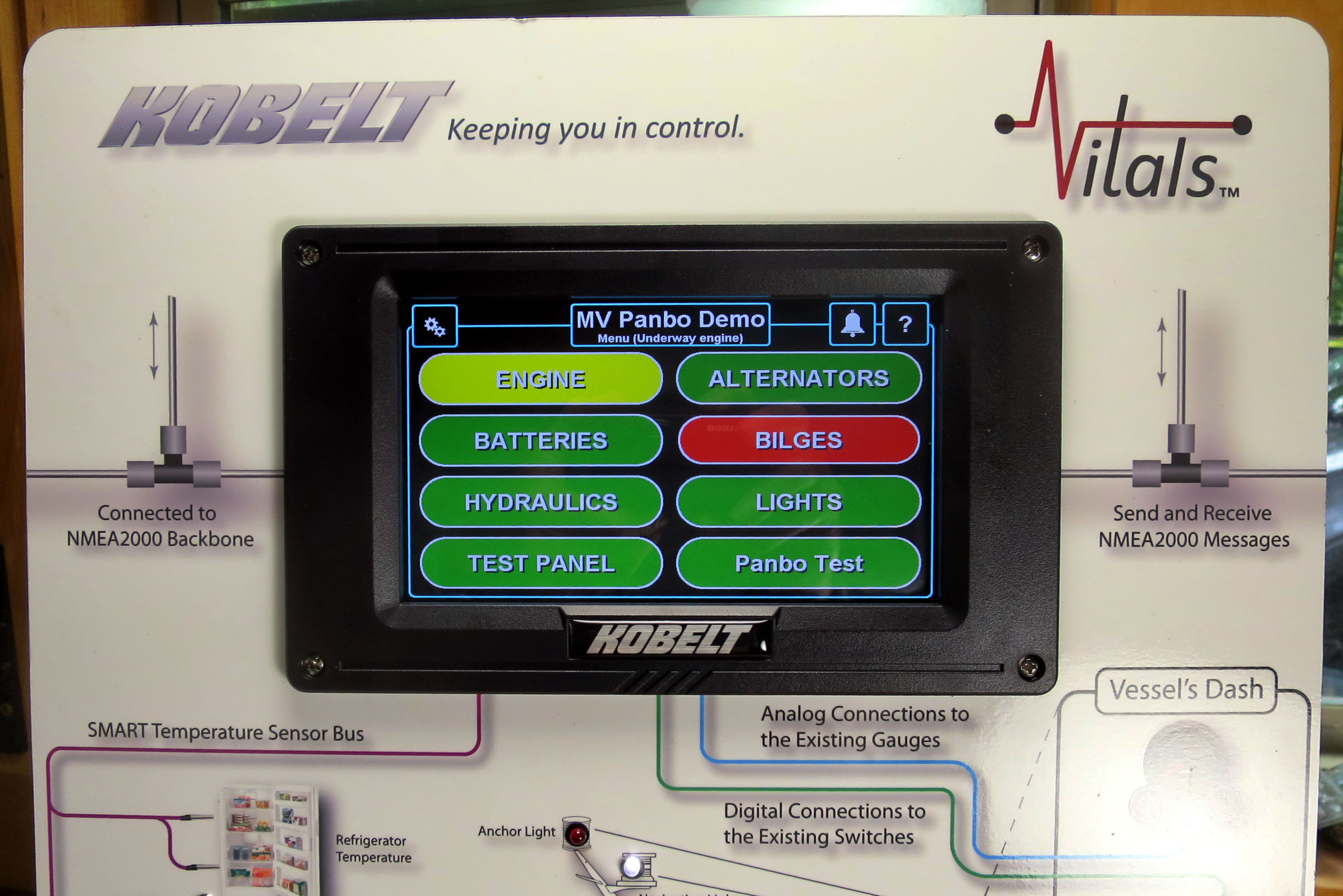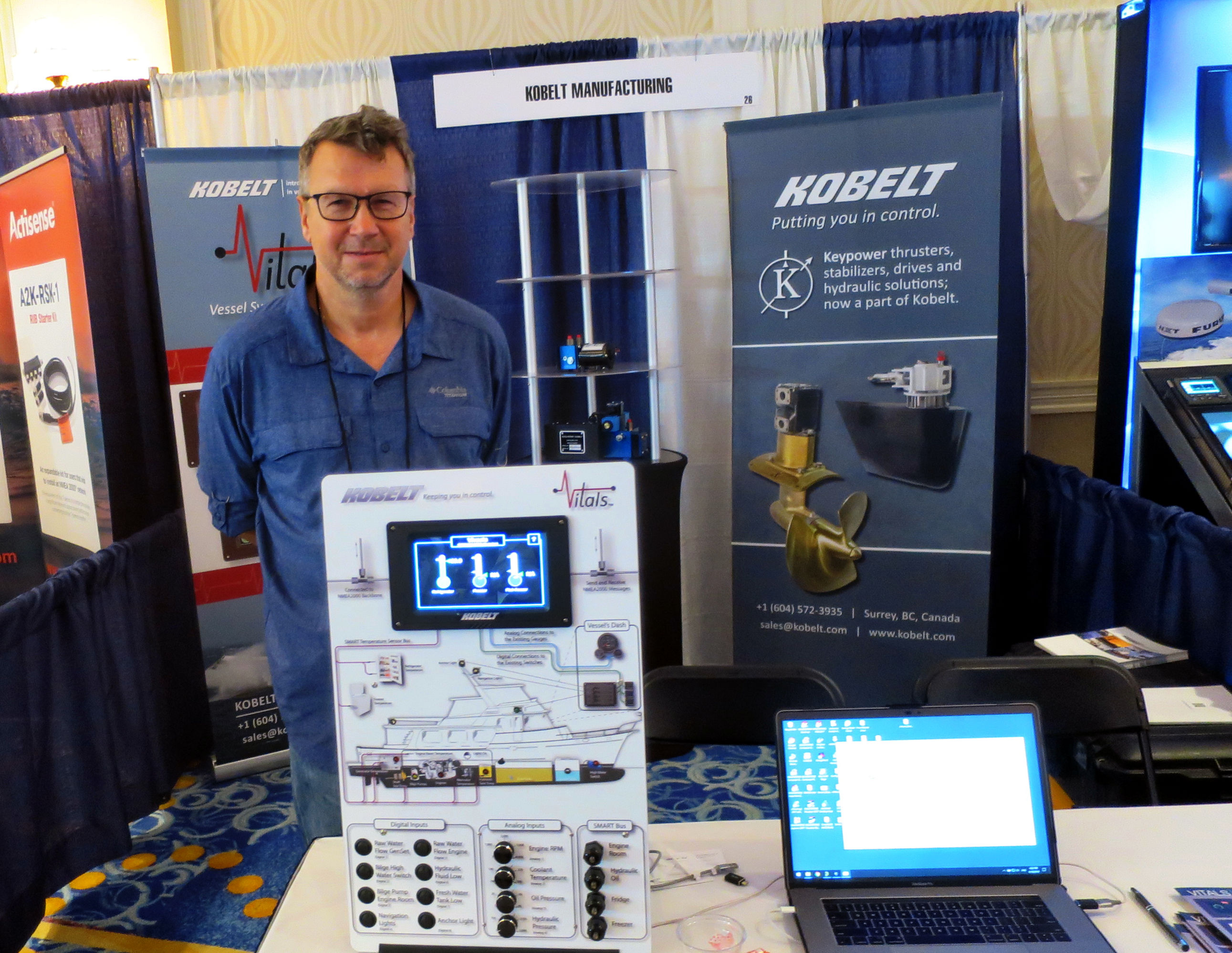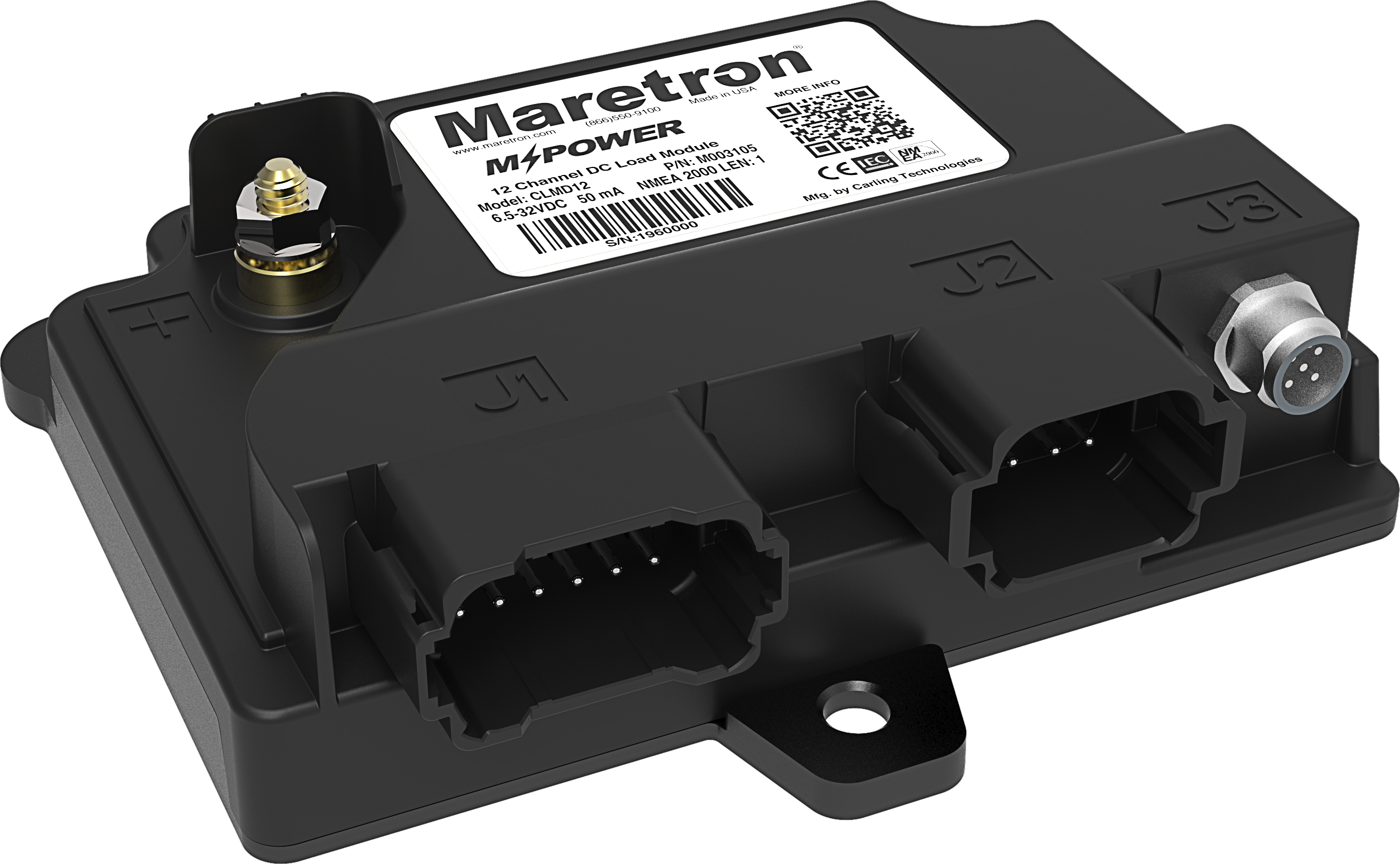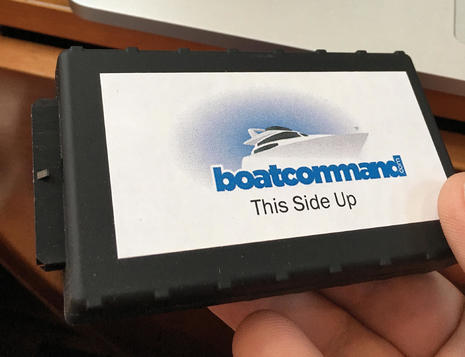Kobelt Vitals: a new sensing, monitoring, and gateway powerhouse

Long Maretron experience has taught me that the key benefit of boat monitoring is not screens of sensor readings, though they can be useful; it’s warnings and alarms. Done right — which is not easy — they can help a boat operate longer without major issues, but with a more relaxed operator. So I’m pleased to report that the new Kobelt Vitals offers similarly sophisticated alerting in a freshly thought-out, reasonably priced, and very flexible design that may be just right for many mid-size vessels.
The heart of Vitals is the 6700 Vessel System Monitoring & Smart Alarm Device seen above. Retailing at $1,695.00, the 7-inch touch display is the main place you manage and receive warnings and alarms, and the 6700 box includes so many sensor input options that it may be all that’s needed to build a sophisticated monitoring system.
The Vitals demonstration panel that Kobelt lent me for testing nicely illustrates the built-in abilities of the 6700 device. 4 rheostats and 8 switches simulate some of the many analog inputs that can be directly sensed, configured, and alarmed by Vitals’ array of 4 voltage, 2 resistive, 2 rpm (pulse), and 8 on/off (digital high or low) inputs. And the panel also includes 4 temperature sensors of the 12 possible with the box’s “Smart Bus” 3-wire sensor network and its 100-foot maximum run.
In other words, with only some thin wire runs and a dozen of the temp sensors Kobelt can provide, you could have the approximate equivalent of the Actisense EMU-1 analog engine device that’s so improved my boat — plus a Maretron SIM100 switch indicator and two of the TMP100 temperature monitors (that I’ve also found very useful) — along with the means to configure and monitor them.
And, yes, all that built-in sensing can gateway onto a connected NMEA 2000 network for use on other displays. Moreover, data already on the N2K bus can be monitored and alarmed on the 6700, and the same bridging and monitoring features apply to the NMEA 0183 rx/tx port (though that’s the only protocol I didn’t try). And, if all that doesn’t get you in touch with every boat system you want to sense, Kobelt has designed simple expansion modules discussed further below.

Panbo Test panel also showing touch gauge editing 
Bilge Panel showing how some special gauge icons are available 
Engine Panel, also showing touch alarm controls for Coolant Temp gauge 
Context help available when editing a gauge alarm
Now let’s peek at how you — or the professional marine electronics technician who may be much better at installing Vitals — sets up the display panels, and what they look like. First of all, the panels can be custom named Engine, Alternators, Batteries, Panbo Test, etc. — as seen on the main screen in the opening photo. Then you can long tap on an area of blank panel to insert a new gauge, or long tap on an existing gauge to use the edit menu seen upper left.
Some gauge graphics are quite specialized, as in that Bilge panel, and Vitals uses the gauge type to filter the possibly long list of sensor inputs the installer scrolls through to feed the gauge. So if you’re, say, setting up the Engine Room Temp gauge (lower left), you’ll choose from a list of Smart Bus sensors as well as NMEA 2000 devices broadcasting a temperature PGN.
That Engine panel photo also shows what you get when you tap on a gauge that’s in a (RED!) alarm state, which I simulated by cranking up the Coolant Temp rheostat. The temp gauge itself is hidden behind the dialog window, which unfortunate for a still photo illustration, but also why I made the alarm video below. But before we go there, please note the extensive context-sensitive help that Vitals can provide. The Vitals Owner’s Manual is pretty good, but these onscreen additions are so valuable I wished they could also be printed out.
I hope you have sound turned on while watching this. Because it really doesn’t matter much that the Vitals Bilge Panel pump graphic neatly animates when the pump is active. You might not have the panel open, or might be elsewhere on the boat, so what does matter is the audio alarm sounded by the 6700’s two Watt speaker output or maybe an on-deck alarm light driven by its 0.5a relay.
What also matters is how the Bilge Panel tab on the Vitals’s main screen will go red in this alarm situation — or yellow for a warning — and it will stay that color if you acknowledge the audio alarm but want to be reminded that the alarming condition still exists. That’s sophisticated boat monitoring.
False alarms are the bane of good monitoring — the helpful software mate is revealed as a nuisance, and “to hell with all that” becomes tempting — but it takes some smarts to avoid them. For instance, the cumulative bilge pump alarm in the video is for a given time period, so a dry boat like Gizmo might be set to fire if the main bilge pump runs more than 90 seconds in 24 hours. Vitals (and Maretron) also have modes like Underway, Anchored, etc. because some warnings and alarms are valuable in some situations but useless in others.
Vitals also lets you build smarter warnings or alarms with Rules, and I’ve used a personal bad habit to create the illustration above. Since I installed LED running lights, I almost always use them underway — why not? — but I sometimes forget to turn them off. So in the upper-left screen, I’ve selected a simple trouble light panel gauge icon, named it NavLights, and selected the Digital input representing a signal wire to the light circuit.
If I’d left that gauge without an alarm, it would simply turn green when I switched the running lights on, which might useful for, say, a panel named Underway Checklist. And had I left it with a “Simple on/off alarm” the buzzer would go off whenever the lights were on, obviously much more appropriate for a digital input like a high bilge sensor.
But I applied an alarm rule called “Engine OFF” that I could create from that same Edit Alarm page or from the drop-down list of already built rules shown lower-left. And note that you don’t have to touch type that rule syntax because the Create Rule sub page not shown walks you through the process.
Moreover, current Vitals users no longer need to consult a homemade input list to know that “Analog, Input 1” is, say, Volvo Penta RPM. As a longtime fan of Maretron’s excellent labeling feature, I complained about this to Kobelt when I was trying out the panel in August. And when I saw a similar demo panel at the NMEA Conference a few weeks later, the revised Vitals firmware already supported alias names for inputs.
Here’s where I’ll add an aside about Vitals graphics. I agree with those who think they look rather old-school clunky. And I also wish that the 6700’s front side was all flat glass (not just because it’s the modern style; it makes touch control easier). But then again, the Vitals look makes some sense given that Kobelt has been manufacturing heavy-duty marine steering, stabilization, and electronic control products since 1962.
I think it’s reassuring that a fairly complex and techy monitoring system is offered by a company that’s used to building and supporting marine products for the long haul. And, besides, while smart warnings and alarms are the primary goal, at least the Vitals screen graphics could be polished up with a simple software update and, from what I’ve seen, that may happen soon.

Vitals Settings Menu 
PGNs of incoming N2K data 
Sources of N2K PGN fields can be different sensors and data formats 
Vitals N2K output seen on Garmin display
In fact, Vitals was introduced almost a year ago and is purportedly installed on numerous vessels already, though still very much under development. So there are features I’ll only reference with the screens above. For instance, the Settings panel above suggests how you can create calculated sources — like two or more fuel tank volumes added up to Total Fuel Remaining — and save/backup/restore entire Vitals setups.
Vitals can also display the realtime NMEA PGNs on the attached network, and even ones recently seen (grayed out). And the PGN output edit feature lower left is very powerful. Note how I’ve populated the dynamic engine message with three different inputs (which would all have much more informative alias names in the current Vitals) and that the various created PGNs seemed to work fine with an old Garmin N2K instrument display.

Mockup of recently added Vitals offboat SMS module 
Vitals SMS messaging examples 
Vitals Digital Input Module adds monitoring of 12 switch states from 3 sources 
Vitals high temp Smart Bus 3-wire sensor
At NMEA and IBEX, Kobelt was also demonstrating a new SMS module that can smartly forward Vitals warnings and alarms to you or others off the boat (and they’ll be at METS). Moreover, I’m told that the Vitals web page will soon detail Analog and Digital Expansion Modules that connect back to the 6700 via N2K, as well as a Smart Bus expansion hub and high temp sensors. I also understand that longterm data logging and analysis is on the Vitals roadmap, as well as digital switching (as opposed to simple switch monitoring).

Trying out the Vitals demo panel obviously impressed me, but I also appreciate the human story behind it. In 2004, Jordan Shishmanov — already well seasoned as a marine technology product manager — and his wife purchased a 1972 William Garden designed and Cheoy Lee built trawler they named Seawitch. Nine years and many boat projects later Jordan stopped updating the Seawitch website, but that’s understandable given that they cruised the boat all the way from Vancouver to New Zealand, and Vitals was born along the way. Now, that’s a beta test.































I’m a subscriber but I have no comment. I just want to be notified when there are comments. How do I do that? Thanks!
Hi Jim, You can manage notifications to this or any entry with the link (maybe not obvious) right below the blank comment window. Look for “You can manage the subscriptions of this post” and the link is in “manage the subscriptions”
Ben, this looks really promising – I especially like the way it can use existing N2K data, along with data from it’s own sensors. It seems like most of the other monitoring systems – especially those that are focused on remote vessel monitoring – depend on adding a bunch of proprietary sensors, adding a lot of extra wiring and often duplicating information that is already available on the NMEA2000 buss… The labeling and customization features you mentioned are also big plusses.
Now if only they could modernize that display! Maybe they could hire somebody from Pico (or Apple) or somewhere…. 😉
Kobelt’s primary audience is commercial marine I think. In which case function, durability and ease of setup, rate much higher than the look. My guess would be that’s what’s driving the graphics and overall design.
Colin, you’re right about Kobelts history and their design priorities – my point was simply if they wish to market this to the wider recreational market, folks are going to expect a display more in keeping with current technology from others in this field – perhaps Apple was a poor example, but that was more in jest. I don’t think durability and an attractive, modern display need to be mutually exclusive…
Have y’all seen the PanelPilotAce by Lascar Electronics? https://www.lascarelectronics.com/panelpilot-displays/panelpilotace/
What do you think?
I haven’t come across them before but I’m pretty intrigued now. The prices look very friendly and they look they’ve got a lot of functionality. Have you had any experience with them?
-Ben S.
No, I just saw them yesterday on the YouTube channel SV Seeker, someone made a ruder indicator out of one. They have a YouTube channel, with several recent videos, definitely not marine focused but interesting non the less. I don’t know enough about their “can” function, I wonder if S70-CAN will read NMEA 2000? If it can get data from signal K or NMEA2000 I could see it being very useful.
Hi Joel,
I find the way we implemented Modbus RTU to be very user friendly, you could use something like this to convert the signal to NMEA2000:
http://www.adfweb.com/home/products/NMEA2000_Modbus.asp?frompg=nav14_1
Feel free to message me about various projects [email protected]